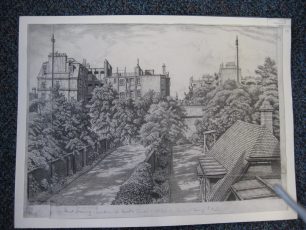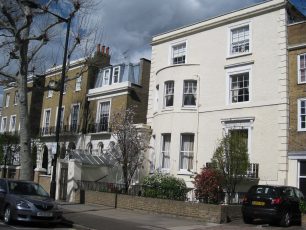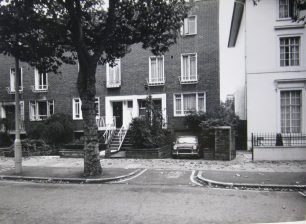Hamilton Terrace in the Twentieth Century
The effects of two World Wars
Long term inhabitants of Hamilton Terrace
The south end of Hamilton Terrace was to spend over fifty years being a comfortable and respectable address for many families during the prosperous period from around 1860 until the 1914-1918 war, as was the rest of the Terrace which by the 1860s had been developed as far north as Abercorn Place. The final plots of the Terrace were also built on by that time but it was named Upper Hamilton Terrace. This address, which was not to change until 1936/7 when it was finally incorporated into the Terrace, involved a third re-numbering.
A number of the families who had moved into these ‘desirable’ properties stayed in them for years and years, even until the Second World War. Richard Winter, for example, who gave his profession as “Government”, lived at 60 Hamilton Terrace with his family from 1838 until 1911. The artist William Strang moved into no 20 in 1900, and after his death in 1921 his widow stayed on until her death in 1934, after which their son David Strang, a skilled etcher, lived in his father’s studio in the garden of no 20 until 1959.
A doctor, Edwin Humby, occupied no 17, the house made famous earlier by the Bazalgette family, from 1861 until his death 30 years later. His first wife Elizabeth had died in childbirth in 1847 aged 20 and has a memorial in St Johns Wood church. Her three week old baby survived and he had remarried by the census of 1851. He was the doctor that Sir Edwin Landseer consulted. He died at 83 Hamilton Terrace in 1890when his widow and later his daughter continued to live on in the house until the 1920s. So this family was there for over 60 years.
Another long-stay resident was Gottlieb Bauer, a chemical and mineral merchant who occupied 66 Hamilton Terrace from 1881 until the 2nd World War. Living at 45 Hamilton Terrace in 1911 was Victor Henkel, a grain merchant with his wife Lily Henkel and their family of four. Lily Henkel was a well-known pianist at the time and after her husband’s death continued to live at no. 45 until her death in 1946.
Effects of two wars
Although the Electoral Rolls, a valuable resource for historical research, were not taken during either of the wars it becomes apparent that when they were restarted changes had taken place in some of the households. In 1918 at no 40 the family Bates had two sons “absent on military service” as were Lieut Alexander Bartley at no 52 and Charles Collard at no 64.
Dr Charles Morier, living at 61 Hamilton Terrace, was in his fifties when the First War took place but went into the Army. Happily he returned home after the end of the war and stayed there until the beginning of the 1930s. But some did not and the ‘head of household’ became ‘widow’.
Changes were very apparent after the Second World War. Some houses had probably been left vacant during the war whilst bomb damage destroyed no 27 which was not replaced until the mid fifties. 27 and 29 Hamilton Terrace were replaced by a short terrace of four houses, including 29a which was occupied since it was built by the Hon Roger Eden who continued to live there until shortly before he died in 2016.Some of the larger ones were divided into flats. In the 1950s 41 Hamilton Terrace became the Nurses’ Home for the Maida Vale Hospital for Nervous Diseases which was round the corner on Edgware Road. It did not revert back to a private house until the hospital was closed in 1983.
In the 1980s 31 Hamilton Terrace was the Senegal Ambassador’s residence. A visit of the Senegalese President to the house was made in a Rolls Royce specially adapted to accommodate his great stature!
18 out of the 66 houses in the southern block had been converted into flats by 1984. And it was not until the 1990s that Westminster City Council and the John Lyon Trust encouraged the conversion of these back into single dwellings.












No Comments
Add a comment about this page